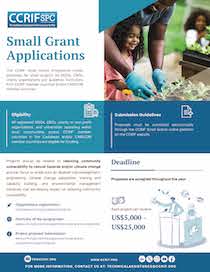Grand Cayman, Cayman Islands, January 7, 2019. CCRIF SPC is pleased to announce that the Government of Panama has joined the Facility and has purchased parametric insurance cover for excess rainfall. Panama joined the Facility as a late entrant this policy year which began on June 1, 2018. CCRIF’s membership now stands at 21 countries – 19 Caribbean governments and 2 Central American governments. CCRIF welcomed four new countries to the Facility this policy year - British Virgin Islands, Montserrat, St. Maarten and now Panama, with Panama being the Facility’s second member from Central America.
In the Caribbean and Central America the frequency of natural hazards and disasters is increasing, and although mortality resulting from disasters seems to be decreasing, economic costs are rising precipitously. In Panama for example, events related to excess rainfall, such as “La Purisima” in 2010 and the floods in the Province of Colon in 2012, come to mind, both of which caused losses of more than US$270 million and forced, on one occasion, the temporary closure of the Panama Canal operations.
CCRIF currently provides parametric insurance to these two regions. The Facility aggregates disaster risks within the two regions but keep the risks segregated across regions, thereby achieving the kind of risk diversification and spreading that members are not able to attain on their own. Empirical evidence based on studies undertaken by the World Bank illustrates that insurance obtained through CCRIF could be as low as half the cost of coverage a member country could obtain by approaching the reinsurance market on its own.
CCRIF’s parametric insurance products are insurance contracts that make payments based on the intensity of an event (for example, hurricane wind speed, earthquake intensity, volume of rainfall) and the amount of loss calculated in a pre-agreed model caused by these events. Therefore, payouts can be made very quickly – within 14 days of the event. This is different from traditional or indemnity insurance settlements that require an on-the-ground assessment of individual losses after an event before a payment can be made. Importantly countries in the Caribbean and Central America are also less insured against natural disasters, with data from reinsurer SwissRe showing that less than 10% of losses are covered by insurance in middle- income countries compared to over 40% in developed countries, the latter using both insurance and capital markets to hedge the immediate adverse impacts of natural disasters.
CCRIF therefore occupies a unique space in the disaster risk management (DRM) arena by being able to effectively provide a level of financial protection through insurance for countries vulnerable to tropical cyclones, earthquakes and excess rainfall and by allowing these countries to increase their financial response capacity in the aftermath of disasters and reduce their economic and fiscal burden. It is well known that left unchecked, the economic impact of natural disasters can generate large losses that disrupt long-run economic growth and development trajectories. Notwithstanding, countries need to be mindful that CCRIF was not designed to cover all losses on the ground but rather to provide capital for emergency relief and early recovery needs, thereby reducing post-disaster resource deficits and government budget volatility. CCRIF is therefore encouraged that the Government of Panama’s participation in the Facility forms part of the implementation of that country’s Strategic Framework for Financial Management of Disaster Risk, which includes among other initiatives, the development and implementation of retention and risk transfer tools.
Panama’s membership in CCRIF has been facilitated by a Memorandum of Understanding signed in 2015 by CCRIF and the Council of Ministers of Finance of Central America, Panama and the Dominican Republic (COSEFIN). This agreement has enabled Central American countries to formally join the facility to access low-cost, high-quality sovereign catastrophe risk insurance. Nicaragua has been a member of CCRIF since 2015 and to date has received two payouts totaling US$1.6 million. Since the Facility’s inception in 2007, CCRIF has made 38 payouts totaling US$139 million to 13-member governments.
Panama’s participation in CCRIF also coincides with additional donor support from the German Federal Ministry of Economic Cooperation and Development (BMZ), through KfW, which in December 2018 contributed an additional €15 million to support the expansion of CCRIF to Central America. The contribution from KfW was channeled through the World Bank- administered Central America and Caribbean Catastrophe Risk Insurance Program (CACCRIP) multi-donor trust fund, becoming the biggest contribution from a single donor to the Program.
The engagement is part of efforts from donors and the international community to address increasing disaster risks by supporting insurance mechanisms that provide rapid payouts to countries in the aftermath of a disaster. This new funding for the CACCRIP will be used to continue improving the affordability of high-quality sovereign catastrophe risk transfer associated with earthquakes and climate risks for the COSEFIN member countries participating in CCRIF. It will also be used to enhance the capacity of Ministries of Finance to develop and implement disaster risk financing and insurance strategies. The CACCRIP also supports activities in Caribbean Community (CARICOM) countries with similar objectives.
The increase in membership is part of CCRIF’s strategic focus over the next three years. In its recently launched Strategic Plan 2018 – 2021, the Facility has prioritized the scaling up of its operations, which involves three main pillars: increasing member coverage; expanding membership; and developing new products for drought, fisheries, agriculture and public utilities – all with the goal of meeting the demand of current and prospective member governments in both the Caribbean and Central America.
About CCRIF SPC: CCRIF SPC is a segregated portfolio company, owned, operated and registered in the Caribbean. It limits the financial impact of catastrophic hurricanes, earthquakes and excess rainfall events to Caribbean and – since 2015 – Central American governments by quickly providing short-term liquidity when a parametric insurance policy is triggered. It is the world’s first regional fund utilising parametric insurance, giving member governments the unique opportunity to purchase earthquake, hurricane and excess rainfall catastrophe coverage with lowest-possible pricing. CCRIF was developed under the technical leadership of the World Bank and with a grant from the Government of Japan. It was capitalized through contributions to a Multi-Donor Trust Fund (MDTF) by the Government of Canada, the European Union, the World Bank, the governments of the UK and France, the Caribbean Development Bank and the governments of Ireland and Bermuda, as well as through membership fees paid by participating governments. In 2014, an MDTF was established by the World Bank to support the development of CCRIF SPC’s new products for current and potential members, and facilitate the entry for Central American countries and additional Caribbean countries. The MDTF currently channels funds from various donors, including: Canada, through Global Affairs Canada; the United States, through the Department of the Treasury; the European Union, through the European Commission, and Germany, through the Federal Ministry for Economic Cooperation and Development and KfW. In 2017, the Caribbean Development Bank, with resources provided by Mexico, approved a grant to CCRIF SPC to provide enhanced insurance coverage to the Bank’s Borrowing Member Countries.
English





